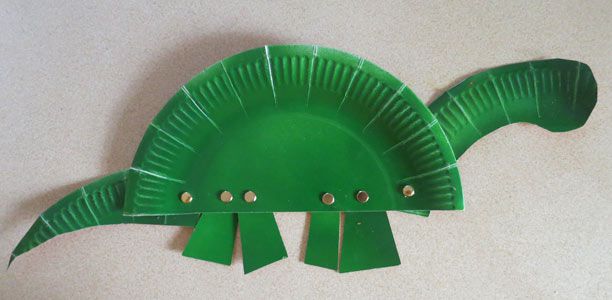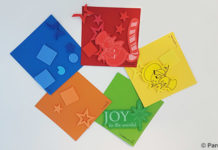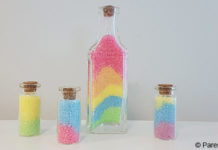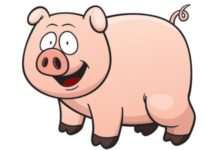Age
2-8 years
Duration of activity
Up to 15 minutes
Materials/equipment
- Paper plate (coloured or uncoloured)
- If uncoloured, paints/crayons/textas.
- Scissors
- Moving clips if you want your dinosaurs limbs to be mobile (or stapler if you don’t have these to hand).
- Optional extras: moving eyes, wool for hair, textas for drawing facial expressions.
Cost
Most of these items you would already have at home, so cost should be negligible.
Preparation
- If you are doing this activity with very young children, cut out the pieces for them first.
- For older children, mark where they need to cut with crayons and supervise.
- For children with more developed skills, allow them to work out how they must cut up the plate by looking at the parts in the picture.
What to do
- If you are using an uncoloured plate, firstly your child needs to paint/colour it green or brown or other dinosaur colour of choice. Leave to dry.
- Cut plate in half, so you have two semicircles.
- One semicircle will form the body of the dinosaur.
- With the other semicircle:
- To make the tail cut half of the rim from the plate, getting narrower to form a tail shape.
- To make the neck and head, cut the remaining rim of the plate making a bulbous shape at the end to form the head.
- For the feet, cut out 4 trapeziums (rectangles which are wider at the bottom than at the top) from the inner circle of the plate.
- Assemble your dinosaur. Either insert clips or staple on legs, neck and tail onto body.
- Optional extras: Older children may enjoy making several dinosaurs and giving each a different character such as painting in a different colour, adding various facial expressions and embellishments.
Safety
Child-safe scissors should be used and supervised for younger children.
Learning outcomes
Fine motor skills
This activity provide plenty of opportunities for your child to develop their fine motor skills. Cutting, colouring or painting and drawing facial expressions on the dinosaur are all tasks which will help your child develop their finger muscles. Toddlers should be able to grip a pencil correctly (instead of, for example clenching it in their fists) by about two and a half years. They’re also ready to start experimenting with other writing implements (e.g. paint brushes) but they’ll be experimenting so be prepared for a bit of mess.
Older children may already be able to use paint brushes and other writing implements but colouring in the dinosaur for this activity provides a great opportunity for them to practice. By 4-5 years of age it’s probably safe to give your child a pair of scissors- but make sure they’re designed for children and you supervise them at all times. Children aged 6-8 years will already be writing and colouring, but will benefit from developing these skills, for example colouring neatly in the lines or writing neatly to label the dinosaur.
Literacy skills
For children over three years old, who are probably starting to write, giving the dinosaur a name and writing it on (or simply labelling it ‘dinosaur’) will help develop their awareness of writing, and how written words are used to represent pictures and other things.
Mathematical skills
Making paper plate dinosaurs also helps your child develop their mathematical skills, for example by learning about shapes, size, colours, space and counting. It’s important to talk to your child about the mathematical concepts as you do this activity, to make sure they get the most out of it. For example you could get them to:
- Discuss the different shapes of the dinosaur’s body parts as you do this activity to help your child learn. For example talk about other objects that are a similar shape to the dinosaur’s tail or feet, get them to put all the feet (rectangles) in a pile, or talk about the shapes’ features (e.g. whether they have straight of curved edges).
- Compare the size of the different body parts (toddlers may only know big and small but older children will be able to compare the size of shapes using increasingly complex comparisons like long and short, and big, bigger and biggest).
- Talk about the dinosaur’s colour and other objects which are similar colours. Also talk about colours which are different (e.g. bright colours if your child has used a dark or dull colour for their dinosaur).
- Talk about where the different body parts are in relation to each other when you have put the dinosaur together. For example is the tail closer to the head or the feet, which objects are to the left or right of each other.
You could also use this activity to teach younger children counting, for example by counting how many legs the dinosaur has. Children generally know how to count to three by the time they reach about three years old, so this might be very challenging for toddlers, and is probably too easy for 4-5 year olds (who can usually count to five or ten). Playing games which allow them to practice counting is a great way to keep developing their early mathematical abilities.
Social and communication skills
Doing activities with your child is a great way to develop their language and communication skills. They will learn new words when they use them in a conversation with you and having a conversation with you will help them master the art of communicating. While they’re still young it’s important to speak in simple sentences. By about age six children will be able to understand increasingly complex grammar, and incorporating this into the conversation will help them master it. Toddlers who are just starting to develop their vocabularies (the 30 or so words which make up the vocabulary of a two year old increase exponentially to about 1000 words by age three, and to about 2000 word by age five) will start to learn new words as you speak to them.
Toddlers will probably also want to direct the conversation by asking simple questions like ‘What’s that?’ (often!), whereas pre-schoolers are more likely to ask ‘why’ or ‘how’ questions. By about three years of age they should be beginning to understand that conversations involve people taking turns and have the skills needed to answer when you ask them questions. As their conversational skills develop, you’ll notice your child’s answers are more elaborate. Conversations you have while doing this activity are a chance to practice and master these skills.
Persistence and problem solving
Even though it’s fun, making dinosaurs will probably be a challenge for your child. Doing the activity with them, and offering them suggestions when they get stuck (e.g. they can’t work out where the tail should go) is a great way to help them learn how to solve problems themselves. Just knowing to ask for help is an important skill, so encourage your child to ask if they can’t work it out alone. But as your child grows up, they’ll be able to do more and more for themselves, and it’s important to give them space to work independently and solve their own problems. They’ll also be learning that challenges can be overcome, and persistence is worth the effort.
References
- Virginia Early Childhood Development Alignment Program. Milestones of child development- A guide to young children’s learning and development from birth to kindergarten. 2009. (cited 26 July 2013). Available from: URL Link
- Queensland Health. Physical and cognitive milestones. 2007. (cited 31 July 2013). Available from: URL Link.
- Queensland Health. Development milestones 6-8 years. 2006. (cited 13 September 2013). Available from URL Link.



 (8 votes, average: 4.50 out of 5)
(8 votes, average: 4.50 out of 5) 






